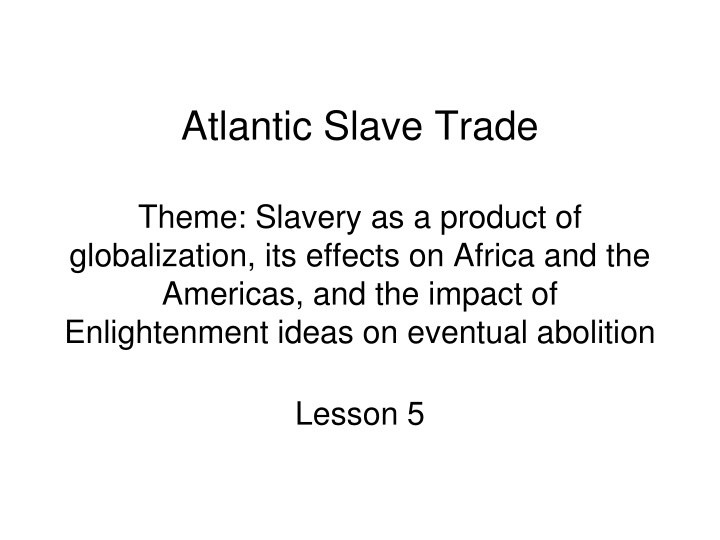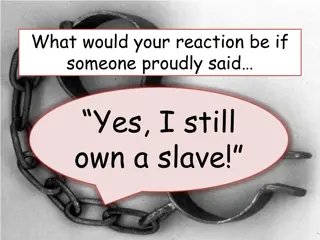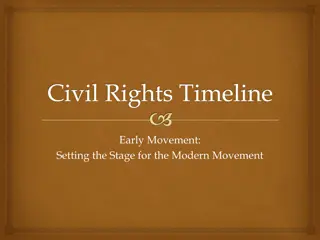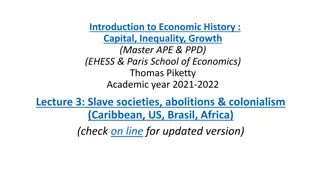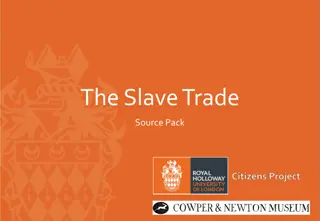The Atlantic Slave Trade: Impact and Abolition
Slavery in Africa, fueled by Bantu migrations, led to a system where slaves had no rights but were crucial for wealth and power. The Islamic and European slave trades further exploited Africans, with the latter expanding significantly with the arrival of Europeans in the Americas. Portuguese slave traders played a key role in this dark chapter of history, ultimately leading to Enlightenment ideas contributing to the eventual abolition of slavery.
Download Presentation

Please find below an Image/Link to download the presentation.
The content on the website is provided AS IS for your information and personal use only. It may not be sold, licensed, or shared on other websites without obtaining consent from the author.If you encounter any issues during the download, it is possible that the publisher has removed the file from their server.
You are allowed to download the files provided on this website for personal or commercial use, subject to the condition that they are used lawfully. All files are the property of their respective owners.
The content on the website is provided AS IS for your information and personal use only. It may not be sold, licensed, or shared on other websites without obtaining consent from the author.
E N D
Presentation Transcript
Atlantic Slave Trade Theme: Slavery as a product of globalization, its effects on Africa and the Americas, and the impact of Enlightenment ideas on eventual abolition Lesson 5
History of African Slavery Slavery has existed since antiquity It became common in Africa after the Bantu migrations spread agriculture to all parts of the continent
History of African Slavery Most slaves in Africa were war captives Once enslaved, an individual had no personal or civil rights Owners could order slaves to do any kind of work, punish them, and sell them as chattel Most slaves worked as cultivators
History of African Slavery African law did not recognize individual land ownership so wealth and power in Africa came from not owning land but by controlling the human labor that made it productive Slaves were a form of investment and a sign of wealth
Islamic Slave Trade After the 8thCentury, Muslim merchants from north Africa, Arabia, and Persia sought African slaves for trade in the Mediterranean basin, southwest Asia, India, and as far away as southeast Asia and China The Islamic slave trade lasted into the 20thCentury and resulted in the deportation of as many as 10 million Africans
European Slave Trade By the time Europeans arrived in Sub-Saharan Africa in the 15thand 16thCenturies, the slave trade was a well-established feature in African society A detailed system for capturing, selling, and distributing slaves had been in place for over 500 years With the arrival of the Europeans and the demand for slaves in the Americas, the slave trade expanded dramatically
Portuguese Slave Traders Portuguese began capturing slaves in Africa in the 15th Century, but quickly learned it was easier to buy them In Europe, slaves usually worked as miners, porters, or domestic servants since free peasants and serfs cultivated the land Europeans and Africans Meet to Trade
Portuguese Slave Trade When the Portuguese discovered the Azores, Madeiras, Cape Verde Islands, and Sao Tome in the 15th Century they were all uninhabited The Portuguese population was too small to provide a large number of colonists The sugar plantations required a large labor force Slaves filled this demand Cape Verde Sao Tome
Slave Trade and Sugar By the 1520s some 2,000 slaves per year were shipped to Sao Tome Some thereafter, Portuguese entrepreneurs extended the use of slave labor to South America Eventually Brazil would become the wealthiest of the sugar-producing lands in the western hemisphere
Slavery Expands As disease reduced the native populations in Spanish conquered territories, the Spanish began relying on imported slaves from Africa In 1518, the first shipment of slaves went directly from west Africa to the Caribbean where the slaves worked on sugar plantations By the 1520s, the Spanish had introduced slaves to Mexico, Peru, and Central America where they worked as cultivators and miners By the early 17th Century, the British had introduced slaves to North America
Triangular Trade The demand for labor in the western hemisphere stimulated a profitable three- legged trading pattern European manufactured goods, namely cloth and metal wares, especially firearms, went to Africa where they were exchanged for slaves The slaves were then shipped to the Caribbean and Americas where they were sold for cash or sometimes bartered for sugar or molasses Then the ships returned to Europe loaded with American products
Typical Triangular Trade Route
Molasses to rum to slaves Who sail the ships back to Boston Ladened with gold, see it gleam Whose fortunes are made in the triangle trade Hail slavery, the New England dream! Song from the play 1776
Capture The original capture of slaves was almost always violent As European demand grew, African chieftains organized raiding parties to seize individuals from neighboring societies Others launched wars specifically for the purpose of capturing slaves
Middle Passage Following capture, slaves were force- marched to holding pens before being loaded on ships The trans-Atlantic journey was called the Middle Passage The ships were filthy, hot, and crowded
Middle Passage Most ships provided slaves with enough room to sit upright, but not enough to stand Others forced slaves to lie in chains with barely 20 inches space between them
Middle Passage Crews attempted to keep as many slaves alive as possible to maximize profits, but treatment was extremely cruel Some slaves refused to eat and crew members used tools to pry open their mouths and force-feed them Sick slaves were cast overboard to prevent infection from spreading During the early days of the slave trade, mortality rates were as high as 50% As the volume of trade increased and conditions improved (bigger ships, more water, better nourishment and facilities), mortality eventually declined to about 5%
Middle Passage The time a ship took to make the Middle Passage depended upon several factors including its point of origin in Africa, the destination in the Americas, and conditions at sea such as winds, currents, and storms. With good conditions and few delays, a 17th Century Portuguese slave ship typically took 30 to 50 days to sail from Angola to Brazil. British, French, and Dutch ships transporting slaves between Guinea and their Caribbean island possessions took 60 to 90 days. As larger merchant ships were introduced, these times reduced somewhat
Arrival When the slave ship docked, the slaves would be taken off the ship and placed in a pen There they would be washed and their skin covered with grease, or sometimes tar, to make them look healthy (and therefore more valuable) They would also be branded with a hot iron to identify them as slaves
Auctions Slaves were sold at auctions Buyers physically inspected the slaves, to include their teeth as an indication of the slave s age Auctioneers had slaves perform various acts to demonstrate their physical abilities
Auctions We were not many days in the merchant s custody, before we were sold after their usual manner... On a signal given, (as the beat of a drum), buyers rush at once into the yard where the slaves are confined, and make a choice of that parcel they like best. The noise and clamor with which this is attended, and the eagerness visible in the countenances of the buyers, serve not a little to increase the apprehension of terrified Africans... In this manner, without scruple, are relations and friends separated, most of them never to see each other again. I remember in the vessel in which I was brought over... there were several brothers who, in the sale, were sold in different lots; and it was very moving on this occasion, to see and hear their cries in parting. Olaudah Equiano, The Interesting Narrative of Olaudah Equiano
Volume of the Slave Trade Late 15th and 16thCentury 2,000 Africans exported each year 17thCentury 20,000 per year 18thCentury 55,000 per year 1780s 88,000 per year All told, some 12 million Africans were transported to the western hemisphere via the Atlantic Slave Trade Another 4 million died resisting capture or during captivity before arriving at their destination
Plantations Most African slaves went to plantations in the tropical or subtropical regions of the western hemisphere The first was established by the Spanish on Hispaniola in 1516 Originally the predominant crop was sugar In the 1530s the Portuguese began organizing plantations in Brazil, and Brazil became the world s leading supplier of sugar
Plantations In addition to sugar, plantations produced crops like tobacco, indigo, and cotton All were designed to export commercial crops for profit Relied almost exclusively on large amounts of slave labor supervised by small numbers of European or Euro- American managers Brazilian sugar mill in the 1830s
Slavery in the Caribbean and South America Disease, brutal working conditions, and poor sanitation and nutrition resulted in high mortality rates Owners imported mainly male slaves and allowed few to establish families which resulted in low reproduction To keep up the needed numbers, plantation owners imported a steady stream of slaves Of all slaves delivered to the western hemisphere, about 50% went to Caribbean destinations About 33% went to Brazil Smaller numbers went elsewhere in South and Central America
Slavery in North America Diseases took less of a toll in North America and living conditions were usually less brutal Plantation owners imported large numbers of female slaves and encouraged their slaves to form families and bear children Only about 5% of slaves delivered to the western hemisphere went to North America
Forms of Resistance Work slowly Sabotage Runaway Maroons gathered together and built self-governing communities Revolt Slaves outnumbered the owners and supervisors so revolt was always a threat While causing much destruction, revolts were usually able to be suppressed because the owners had access to arms, horses, and military forces
Saint-Dominique The only revolt to successfully abolish slavery as an institution occurred on the French sugar colony of Saint Dominique in 1793 The slaves declared independence from France, renamed the country Haiti, and established a self- governing republic in 1804 Francois-Dominique Toussaint was one of the military leaders of the Saint-Dominique revolt
Abolitionists Former Slaves Olaudah Equiano Politicians William Wilberforce Religious Leaders John Wesley Revolutionaries Simon Bolivar
Former Slaves: Olaudah Equiano Equiano was originally from Benin and was captured by slave raiders when he was 10 Spent 21 years as a slave and was able to save up enough money to buy his freedom In 1789 he published The Interesting Narrative of Olaudah Equiano, or Gustavus Vassa, the African, Written by Himself Sold the book throughout Britain, undertaking lecture tours and actively campaigning to abolish the slave trade
Politicians: William Wilberforce English philanthropist elected to Parliament in 1780 Delivered a stirring abolitionist speech to the House of Commons in 1789 and repeatedly introduced the Abolition Bill until it passed in 1807
Religious Leaders: John Wesley Founder of the Methodist Church Published Thoughts Upon Slavery in 1774 On his deathbed he was reading Equiano s Narrative
Revolutionaries: Simon Bolivar Inspired by George Washington and Enlightenment ideas, Bolivar took up arms against Spanish rule in 1811 Freed slaves who joined his forces Provided constitutional guarantees of free status for all residents of Gran Columbia (Venezuela, Columbia, and Ecuador)
Timeline for Abolition of the Slave Trade 1803: Denmark abolishes slave trade. 1807: Britain abolishes slave trade. 1807: U.S. passes legislation banning slave trade, to take effect 1808. 1810: British negotiate an agreement with Portugal calling for gradual abolition of slave trade in the South Atlantic. 1815: At the Congress of Vienna, the British pressure Spain, Portugal, France and the Netherlands to agree to abolish the slave trade (though Spain and Portugal are permitted a few years of continued slaving to replenish labor supplies). 1817: Great Britain and Spain sign a treaty prohibiting the slave trade: Spain agrees to end the slave trade north of the equator immediately, and south of the equator in 1820. British naval vessels are given right to search suspected slavers. Still, loopholes in the treaty undercut its goals and the slave trade continues strongly until 1830.
Slavery Continues Abolishing the slave trade did not end slavery British ships patrolled the west coast of Africa to halt illegal trade The last documented ship that carried slaves across the Atlantic arrived in Cuba in 1867
Timeline for Abolition of Slavery 1813: Gradual emancipation adopted in Argentina. 1814: Gradual emancipation begins in Colombia. 1823: Slavery abolished in Chile. 1824: Slavery abolished in Central America. 1829: Slavery abolished in Mexico. 1831: Slavery abolished in Bolivia. 1833: Abolition of Slavery Act passed in Britain which results in complete emancipation by 1838. 1842: Slavery abolished in Uruguay. 1848: Slavery abolished in all French and Danish colonies. 1851: Slavery abolished in Ecuador.
Timeline for Abolition of Slavery 1854: Slavery abolished in Peru and Venezuela. 1863: Emancipation Proclamation issued in the U.S. 1863: Slavery abolished in all Dutch colonies. 1865: Slavery abolished in the U.S. as a result of the Thirteenth Amendment to the Constitution and the end of the Civil War. 1871: Gradual emancipation initiated in Brazil. 1873: Slavery abolished in Puerto Rico. 1886: Slavery abolished in Cuba. 1888: Slavery abolished in Brazil. 1960s: Slavery abolished in Saudi Arabia and Angola
Emancipation Proclamation Issued by President Lincoln after the Federal victory at Antietam That on the first day of January, in the year of our Lord one thousand eight hundred and sixty-three, all persons held as slaves within any State or designated part of a State, the people whereof shall then be in rebellion against the United States, shall be then, thenceforward, and forever free
Impact of Emancipation Proclamation on Confederate Diplomatic Efforts the feeling against slavery in England is so strong that no public man there dares extend a hand to help us There is no government in Europe that dares help us in a struggle which can be suspected of having for its result, directly or indirectly, the fortification or perpetuation of slavery. Of that I am certain William Yancey, Confederate politician
Impact of Slave Trade in Africa Mixed Some states like Rwanda largely escaped the slave trade through resistance and geography Some like Senegal in west Africa were hit very hard Other societies benefited economically from selling slaves, trading, or operating ports As abolition took root in the 19th Century some African merchants even complained about the lose of their livelihood On the whole, however, the slave trade devastated Africa Door of No Return on Goree Island off the coast of Senegal
Impact of Slave Trade in Africa The Atlantic Slave Trade deprived Africa of about 16 million people and the continuing Islamic slave trade consumed another several million Overall the African population rose thanks partly to the introduction of more nutritious food from the Americas Peanuts were one of several crops introduced to Africa from the Americas
Impact of Slave Trade in Africa The slave trade distorted African sex ratios Approximately 2/3 of all exported slaves were male Slavers preferred young men between the ages of 14 and 35 to maximize investment potential and be suitable for hard labor The sexual imbalance in some parts of Africa such as Angola encouraged polygamy and caused women to take on duties that had previously been the responsibility of men
Impact of Slave Trade in Africa The slave trade brought firearms to such African societies as Asante, Dahomey, and Oyo and this increased violence In the 18th Century, Dahomey expanded rapidly, absorbed neighboring societies, and fielded an army that was largely a slave-raiding force
African Diaspora Obviously, the main contribution slaves brought to the western hemisphere was an incredible amount of labor, without which the prosperous new societies could not have developed However they brought other contributions as well: Slaves built hybrid cultural traditions made up of African, European, and American elements Influenced language by creating tongues that drew on several African and European languages
Gullah For several reasons, Africans, both as slaves and free, enjoyed a relative amount of self- sufficiency in the Sea Islands off of South Carolina Their culture maintained much of its original characteristics as it encountered American culture For example, most of the Gullah vocabulary is of English origin, but the grammar and major elements of pronunciation come from a number of West African languages
Gullah beat on ayun: mechanic ; literally, beat-on-iron troot ma-wt: a truthful person ; literally, truth mouth hush ma-wt: hush mouth ; literally, hush mouth sho ded: cemetery ;literally, sure dead tebl tappa: preacher ; literally, table-tapper ty oonuh ma-wt: Hush, stop talking ; literally, Tie your mouth krak teet: to speak ; literally, crack teeth i han shaht pay-shun: He steals ; literally, His hand is short of patience
African Diaspora Impacted on cuisine by introducing African foods to Caribbean and American societies For example, combined African okra with European-style saut ed vegetables and American shellfish to make gumbo Introduced rice cultivation to tropical and subtropical regions Fashioned distinctive crafts such as pottery and baskets Sea Island basket
African Diaspora Many slaves were either Christians when they left Africa or converted to Christianity after their arrival in the western hemisphere Their Christianity was not exactly like European Christianity and made considerable room for African traditions Associated African deities with Christian saints Relied heavily on African rituals such as drumming, dancing, and sacrificing animals Preserved their belief in spirits and supernatural powers and made use of magic, sorcery, witchcraft, and spirit possession
Next Capitalism and Industrialism Eli Whitney s cotton gin
